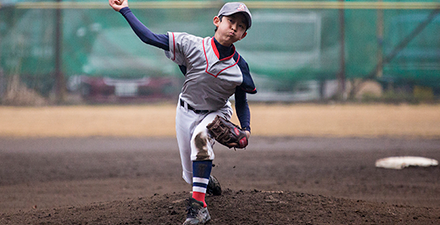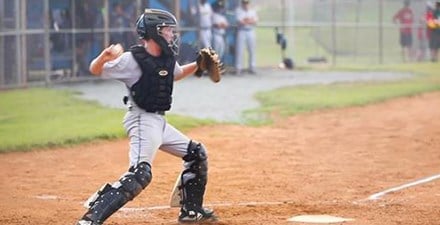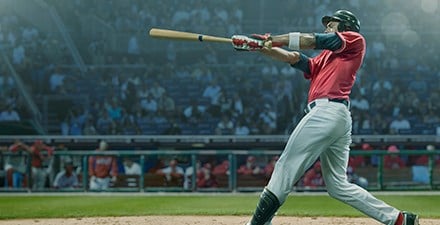Physical Therapy Guide to Pitcher's Elbow
Pitcher’s elbow (medial apophysitis) occurs as a result of an injury or irritation to the inside of the elbow. It is an overuse injury. The condition is most common in young athletes who play sports with repeated overhead movements during stages of rapid growth (ages 11 to 15). It is sometimes called little league elbow. Physical therapists help athletes with pitcher’s elbow safely heal the injury, return to sport, and learn how to prevent future injuries.
Physical therapists are movement experts. They improve quality of life through hands-on care, patient education, and prescribed movement. You can contact a physical therapist directly for an evaluation. To find a physical therapist in your area, visit Find a PT.
What Is Pitcher's Elbow?
Pitcher's elbow occurs when there is irritation to the inside of the elbow joint where the arm bone (humerus) meets one of the bones of the forearm (ulna). In youth, the bones that form the elbow joint are still developing and are more at risk for overuse and growth-related injuries. During pitching, the overhead throwing motion puts stress on this part of the elbow. It can become painful and swollen with:
- Too much stress (throwing too much or using improper movements [mechanics]).
- Lack of recovery (not enough rest time between throwing activities).
This results in the athlete being unable to throw with speed and accuracy at their normal volume. Pitcher's elbow can start as soreness. If not treated early, it can progress to more serious injuries such as ligament tears or bone fractures. If you are experiencing soreness, seek help right away.

How Does It Feel?
With pitcher's elbow, you may experience:
- Pain that slowly worsens at the inside of your elbow when throwing a ball.
- Soreness that lingers at the inside of your elbow after throwing activities.
- Swelling and tenderness around the inside of the elbow area.
- Inability to throw the ball at your normal speed.
- Loss of grip strength.
- Loss of accuracy or distance when throwing.
- Muscle cramping in your forearm.
- Loss of motion of your elbow.
- Discomfort with daily activities such as turning a doorknob or carrying a heavy object in front of you.
How Is It Diagnosed?
A physical therapist conducts a thorough review of the athlete's medical history. This will include specific questions about athletic involvement, such as:
- Sports played.
- Frequency of practices and games.
- Positions played.
- Types and number of pitches thrown.
Your physical therapist will assess your arm for:
- Sensation (ability to feel).
- Motion.
- Strength.
- Flexibility.
- Tenderness.
- Swelling.
Your physical therapist will perform several tests specific to the elbow joint. They also may ask you to briefly show them the activities or positions that cause your pain. Depending on your symptoms, they may assess your throwing mechanics. They also will ask questions to learn details about your experience as a throwing athlete.
Because throwing involves the shoulder and elbow, your physical therapist likely will examine your shoulder. They also may examine your neck and upper back. This will help them find out whether problems in these areas might be contributing to your elbow condition.
If your physical therapist suspects more than an overuse irritation, or if you have a major loss of motion or severe pain, they may refer you to an orthopedic doctor for ultrasound, X-ray, or MRI imaging. Your answers to questions, the clinical exam, and any imaging, are important to determine the nature of your elbow injury.
How Can a Physical Therapist Help?
Your physical therapist will work with you to develop a treatment plan to address pitcher’s elbow. It will be tailored to your specific condition and your athletic goals. Many physical therapy treatments are effective for this condition. Your physical therapist may focus on:
Range of motion. A swollen and stiff elbow can result in an abnormal elbow or shoulder motion. Your physical therapist will assess the motion of both joints compared with the normal motion expected for your age and gender. They will compare these results with your other (unaffected) shoulder and elbow. Your physical therapist will work with you to reduce swelling and stiffness, help you strengthen the appropriate muscles, and restore normal shoulder and elbow range of motion. They also can help you learn proper throwing mechanics.
Strength training. The muscles around the shoulder, elbow, and upper back work together to allow coordinated upper-body motion. This coordination is especially important during throwing. Balancing the strength of upper-body muscles is crucial to making sure the shoulder and elbow joints move efficiently. Your physical therapist will teach you exercises to strengthen the muscles around the shoulder. This will help disperse the stresses on your elbow and make sure that each muscle is able to properly do its job. Additionally, core strength is critical for proper total body mechanics during athletic movements. Your physical therapist will likely incorporate core strengthening into your program.
Manual therapy. Physical therapists are trained in manual (hands-on) therapy. Your physical therapist may gently move and mobilize your elbow and shoulder joint and their surrounding muscles. The goal of hands-on therapy is to improve motion, flexibility, and strength. These techniques can target areas that are hard to treat on your own.
Pain management. Your physical therapist may recommend how and when to use ice and heat to aid in pain management. Physical therapists are experts in treating pain. Physical therapy can reduce the need for pain medicines, including opioids.
Functional training. Most athletes with pitcher’s elbow are learning how to adapt their movements to a growing body. Poor coordination can put undue stress on the shoulder and elbow. Over time, improper movements can cause pain. Physical therapists are experts in assessing movement quality. They teach athletes to function at their best. Your physical therapist will point out any faulty movements. They will help you correct your throwing motion so you can maintain a pain-free elbow.
Education. Your physical therapist will educate you about the necessary steps to heal safely and efficiently. They also will teach you how to best prevent future injuries. The first step to addressing your elbow pain is controlled rest. Your physical therapist will explain why this is so important. They will develop a plan for your recovery that includes a progressive return-to-throwing and exercises. This plan will guide you from your rest phase through a gradual return to throwing activities and help you avoid further injury. Your treatment plan will address your unique condition and goals.
Can This Injury or Condition Be Prevented?
Fortunately, a lot can be done to prevent the cascade of events that lead to pitcher's elbow. Physical therapists help athletes and coaches focus on:
- Following guidelines for throwing.
- Explaining common causes of throwing-related injuries and providing strategies for prevention.
- Educating athletes on the risks of playing through pain.
- Monitoring pitch counts, both during practice sessions and games.
- Monitoring throwing participation (multiple sports, multiple leagues, teams, and positions).
- Allowing enough rest time for athletes to recover between throwing outings.
- Tracking a young athlete’s growth curves (height, weight, and BMI).
- Developing an athlete-specific flexibility and strengthening routine. This routine should be followed throughout the athletic season.
- Encouraging athletes to consult with a physical therapist if symptoms get worse despite rest.
What Kind of Physical Therapist Do I Need?
All physical therapists are prepared through education and clinical experience to treat a variety of conditions or injuries. You may want to consider:
- A physical therapist who is experienced in treating people with orthopedic or musculoskeletal injuries.
- A physical therapist who is a board-certified clinical specialist or who has completed a residency in orthopedic or sports physical therapy, as they will have advanced knowledge, experience, and skills that apply to an athletic population.
You can find physical therapists in your area with these credentials and clinical expertise on Find a PT, a tool built by the American Physical Therapy Association.
General tips when you are looking for a physical therapist (or other health care provider):
- Ask family, friends, and other health care providers to recommend a physical therapist.
- Ask about the physical therapist’s experience treating pitcher’s elbow before you make an appointment.
- Be prepared to describe your symptoms in as much detail as possible on your first visit, including what makes your symptoms better or worse.
The American Physical Therapy Association believes that consumers should have access to information to help them make informed decisions and prepare them for their visit with a health care provider.
The following resources offer some of the best scientific evidence related to physical therapy treatment for pitcher’s elbow. They report recent research and provide information on the standards of practice both in the United States and internationally. They link to a PubMed* abstract (which may also offer free access to the full text) or other resources. You can read them or print out a copy to bring with you to your health care provider.
Carr JB Jr, Camp CL, Dines JS. Elbow ulnar collateral ligament injuries: indications, management, and outcomes. Arthroscopy. 2020;36(5):1221–1222. Article Summary in PubMed.
Agresta CE, Krieg K, Freehill MT. Risk factors for baseball-related arm injuries: a systematic review. Orthop J Sports Med. 2019;25;7(2):232596711982557. Article Summary in PubMed.
Okoroha KR, Lizzio VA, Meta F, et al. Predictors of elbow torque among youth and adolescent baseball pitchers. Am J Sports Med. 2018;46(9): 2148–2153. Article Summary in PubMed.
Shanley E, Thigpen C. Throwing injuries in the adolescent athlete. Int J Sports Phys Ther. 2013;8(5):630–640. Article Summary on PubMed.
Stein CJ, Micheli LJ. Overuse injuries in youth sports. Phys Sportsmed. 2010;38(2):102–108. Article Summary on PubMed.
Benjamin HJ, Briner WW Jr. Little league elbow. Clin J Sport Med. 2005;15(1):37–40. Article Summary on PubMed .
*PubMed is a free online resource developed by the National Center for Biotechnology Information. PubMed contains millions of citations to biomedical literature, including citations in the National Library of Medicine's MEDLINE database.
Expert Review:
Jun 18, 2021
Revised:
Jun 18, 2021
Content Type: Guide
Pitcher's Elbow
PT, DPT, board-certified clinical specialist in sports physical therapy
Laura Pietrosimone
PT, DPT, PhD, board-certified clinical specialist in sports physical therapy
James E. Zachazewski
PT, DPT, board-certified clinical specialist in sports physical therapy, on behalf of the American Academy of Sports Physical Therapy
You Might Also Like...
Health Tips
What Is Little League Elbow?Oct 7, 2024
Little league or pitcher's elbow, also known as medial epicondyle apophysitis, is a common injury among young baseball players. Learn the causes, how to
Video
Physical Therapy for What Moves You: BaseballOct 28, 2019
Mac is 12 years old and the starting catcher for his travel baseball team. A shoulder injury moved him to the bench. Physical therapy helped him recover
Podcast
Avoiding Baseball InjuriesMay 6, 2014
Former Los Angeles Dodgers head physical therapist and trainer Sue Falsone discusses how professional baseball players endure the rigors of a long


